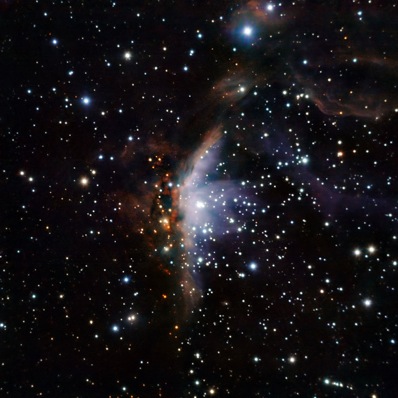
A faint nebula's
split personality
DR EMILY BALDWIN
ASTRONOMY NOW
Posted: 31 March


Dark on one side and bright on the other, the Gum 19 nebula tells a tale of star-formation and demise.
The new infrared image of Gum 19, which is located 22,000 light years away in the direction of the constellation Vela, was obtained by the SOFI instrument on ESO's New Technology Telescope (NTT) at the La Silla Observatory in Chile, its infrared eyes able to peer through some of the nebula's dusty shroud.

Superhot star V391 Velorum fuels Gem 19's luminosity, while fledging stars take hold on the 'dark' side. Image: ESO.
On one side of the nebula hot hydrogen gas is illuminated by a supergiant blue star known as V391 Velorum. A near-vertical bright slash through the heart of the nebula separates this glowing cloud of gas from a dark region of star formation.
Massive V391 Velorum blazes at some 30,000 degrees Celsius and is a variable star, its brightness fluctuating rapidly as a result of strong activity that can include ejections of matter, which contribute to Gum 19’s composition and light emissions. V391 Velorum will not power the nebula forever; after a relatively short lifetime of ten million years it will explode in a powerful supernova event. Gusts of superheated matter blasting from the explosion will likely deform and reshape Gum 19's currently distinctive appearance.
In the meantime, new stars continue to form. Cocooned in blankets of gas and dust that are collapsing under their own gravity, these proto-stars will eventually reach the critical high density that will trigger nuclear fusion. Fresh outpourings of energy and stellar winds from these newborn stars will also modify the gaseous landscape of Gum 19.
|



